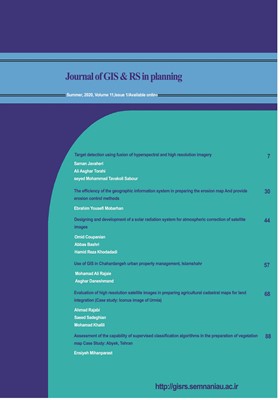target detection using fusion of hyperspectral and high resolution imagery
Subject Areas :saman javaheri 1 , Ali asghar torahi 2 , seyed mohammad tavakoli sabour 3
1 - master of Science, the Department of Remote Sensing and Geographic Information Systems, Faculty of Geographical Sciences, Kharazmi University
2 - professor, the Department of Remote Sensing and Geographic Information Systems, Faculty of Geographical Sciences, Kharazmi University
3 - professor, the Department of Remote Sensing and Geographic Information Systems, Faculty of Geographical Sciences, Kharazmi University
Keywords: Image fusion, Hyperspectral, Target detection, high spatial resolution,
Abstract :
Identification is a mission to learn about the activities, resources, abilities and position of the enemy. Military targets detection can provide commanders with a variety of information on the status of activities, deployment of forces, military arrangement of targets, and many other information from a military area. In recent years, the advancement of remote sensing technology has made it possible to produce different images with high resolution Spectral and spatial. fusion of hyperspectral and high resolution imagery can help effectively identify, extract, and produce maps from the constituent elements of an environment. The purpose of this research is to target detection (military) using fusion of hyperspectral and high resolution imagery. For this reason the Hyperion, ALI and OrbView3 data was acquired. Firstly, Hyperion Data Preprocessing was used in terms of unused bands, bad straights, atmospheric correction and geometric correction. The image of Hyperion in a two-step process with panchromatic bands combined ALI and OrbView3 images using gram-schmidt, Pc Spectral, and IHS algorithms. The combined results showed that Gram schmidt had the best spectral and spatial performance. In the next research, the MNF conversion was used to reduce the image size and reduce the noise, and the PPI algorithm of the purest pixels was used to extract the spectral profile in a visual and precise manner compared with the reference spectra. In the following, algorithms, BANDMAX, spectral angle mapper and divergence spectral information were used to identify the targets. The results of the identification of the objectives showed that the BANDMAX method with a Overall accuracy of 89.25 and Kappa coefficient of 0.723 was better than the other two algorithms.
_||_


